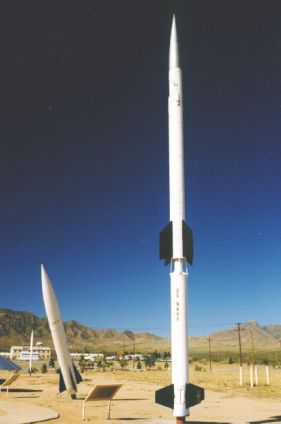Aerojet General Aerobee
(Models 170, 300)
The Aerojet General Aerobee was the first purpose-designed American high-altitude sounding rocket. The initial development was sponsored by the U.S. Navy, and the rocket was used by all U.S. military services from 1947 onwards. Details of all early Aerobee variants up to and including the Aerobee 150 are covered in the article about the PWN-2A Aerobee-Hi. This page here will give brief details on later Aerobee versions used by the military, namely the Aerobee 300 and Aerobee 170.
Aerobee 300 (Spaerobee)
The Aerobee 300 was an Aerobee 150 (including booster), to which a solid propellant rocket motor from an AIM-7 Sparrow missile was attached as an upper stage. The rocket was also called Spaerobee (sometimes written as Sparrowbee). The nose of the Sparrow motor was fitted with a payload fairing of 16.5 cm (6.5 in) diameter, while its tail was modified with a cone, which served both as an interstage adapter and a nozzle optimized for high altitude. The Spaerobee could lift its payload of about 45 kg (100 lb) to altitudes well above 300 km (190 miles). The highest recorded altitude was 415 km (258 miles).
 |
| Photo: NASA |
| Aerobee 300 (without booster) |
The first Spaerobee flight was an unsuccessful Air Force launch on 22 October 1958, but three days later the rocket was fired successfully. The last USAF launch occurred in March 1961, and NASA continued to use the rocket until 1965. In total, 38 Aerobee 300s were launched by the USAF, U.S. Navy and NASA. This total includes seven Aerobee 300A models, which were identical to the 300 except that the first stage was a four-finned Aerobee 150A.
Aerobee 170 (Nike-Aerobee)
When the small booster of the Aerobee 150A was replaced by a Nike booster, the rocket became the Aerobee 170. It must be noted, that although there were both Aerobee 170 and 170A variants, both apparently used the four-finned Aerobee 150A as second stage. With typical payloads, the combination could reach an altitude of about 200 km (125 miles), the highest recorded altiude being 270 km (168 miles).
 |
 | |
| Photo: via P. Alway | Photo: Sven Knudson, Ninfinger Productions | |
| Aerobee 170 | ||
After a test with a dummy Aerobee stage in September 1968, the first all-up Aerobee 170 flight succeeded on 26 October that year. A total of 138 Aerobee 170s of all subtypes were launched until 1983. Although the rocket was primarily used by NASA, the military research groups (e.g. Naval Research Lab and Air Force Cambridge Research Lab) also flew several dozen Aerobee 170s.
Specifications
Note: Data given by several sources show slight variations. Figures given below may therefore be inaccurate!
Data for Aerobee 300A *:
| Length (incl. booster) | 10.33 m (33 ft 10.5 in) |
| Finspan | Booster: 1.56 m (5 ft 1.5 in) 1st stage: 1.20 m (3 ft 11.4 in) |
| Diameter | Booster: 32.5 cm (12.8 in) 1st stage: 38 cm (15 in) 2nd stage: 20 cm (8 in) |
| Weight | 980 kg (2160 lb) |
| Speed | 7080 km/h (4400 mph) |
| Altitude | > 300 km (190 miles) |
| Propulsion | Booster: Aerojet 2.5KS18000 solid-propellant rocket; 83 kN (18600 lb) for 2.5 s 1st stage: Aerojet AJ11 liquid-propellant rocket; 18 kN (4100 lb) for 51.5 s 2nd stage: Solid-propellant rocket; 35 kN (7670 lb) for 1.8 s |
Main Sources
[1] Peter Alway: "Rockets of the World", Saturn Press, 1999
[2] Peter Alway: "Rockets of the World, 1999 Supplement", Saturn Press, 1999
[3] Frederick I. Ordway III, Ronald C. Wakeford: "International Missile and Spacecraft Guide", McGraw-Hill, 1960
[4] Mark Wade: Encyclopedia Astronautica
[5] Jonathan McDowell: Launch Vehicles Database
Back to Directory of U.S. Military Rockets and Missiles, Appendix 4
Last Updated: 13 July 2004